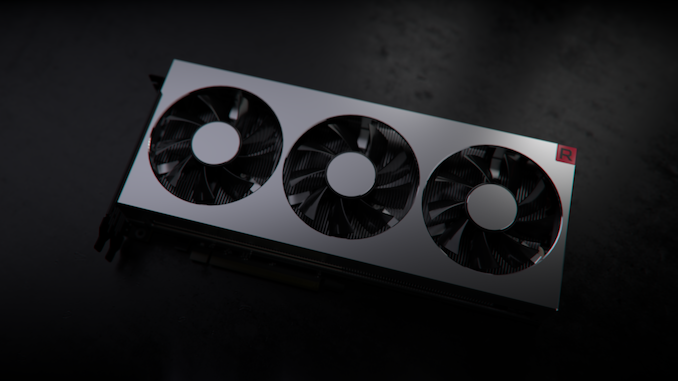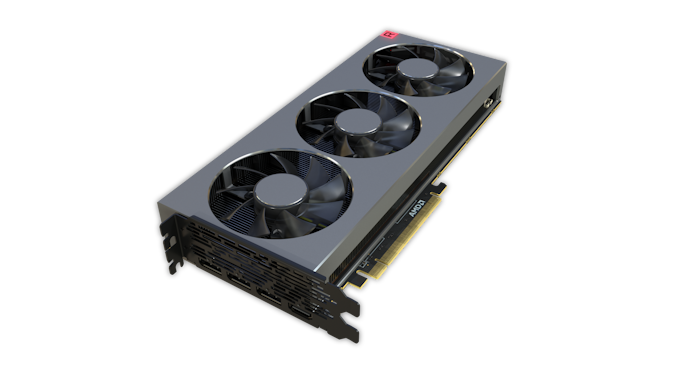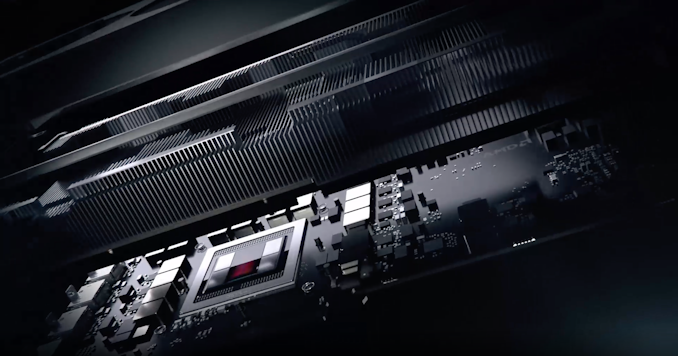The AMD Radeon VII Review: An Unexpected Shot At The High-End
by Nate Oh on February 7, 2019 9:00 AM ESTMeet The Radeon VII
First things first is the design and build, and for the AMD Radeon VII, we've already noticed the biggest change: an open air cooler. Keeping the sleek brushed metal look of the previous RX Vega 64 Limited Edition and Liquid variants, they've forgone the blower for a triple axial fan setup, the standard custom AIB configuration for high-end cards.
While NVIDIA's GeForce RTX series went this way with open-air dual-fan coolers, AMD is no stranger to changing things up themselves. Aside from the RX Vega 64 Liquid, the R9 Fury X's AIO CLC was also quite impressive for a reference design. But as we mentioned with the Founders Edition cards, moving away from blowers for open-air means adopting a cooling configuration that can no longer guarantee complete self-cooling. That is, cooling effectiveness won't be independent of chassis airflow, or lack thereof. This is usually an issue for large OEMs that configure machines assuming blower-style cards, but this is less the case for the highest-end cards, which for pre-builts tend to come from boutique system integrators.
The move to open-air does benefit higher TDP, and at 300W TBP the Radeon VII is indeed one for higher power consumption. While 5W more than the RX Vega 64, there's presumably more localized heat with two more HBM2 stacks, plus the fact that the same amount of power is being consumed but on a smaller die area. And at 300W TBP, this would mean that all power-savings from the smaller process were re-invested into performance. If higher clockspeeds are where the Radeon VII is bringing the majority of its speedup over RX Vega 64, then there would be little alternative to abandoning the blower.
Returning to the Radeon VII build, then, the card naturally has dual 8-pin PCIe connectors, but lacks the BIOS switch of the RX Vega cards that toggled a lower-power BIOS. And with the customary LEDs, the 'Radeon' on the side lights up, as does the 'R' cube in the corner.
In terms of display outputs, there are no surprises here with 3x DisplayPort and 1x HDMI.
A few teardowns of the card elsewhere revealed a vapor chamber configuration with a thermal pad for the TIM, rather than the usual paste. While lower-performing in terms of heat transfer, we know that the RX Vega cards ended up having molded and unmolded package variants, requiring specific instructions to manufacturers on the matter. So this might be a way to head off potential ASIC height difference issues.














289 Comments
View All Comments
Manch - Monday, February 11, 2019 - link
My bad on Wolf. I thought it was. It's on XB1 which is DX12 and DX12 supt was confirmed by a few places so I didn't check further.As for Vulkan Games, off the top of my head(whats in my library), TWS:ToB, TW: Warhammer II (should have been in my table..oops), Warhamer 40K DoW III, Serious SAM VR games, x-plane. I'm sure there are others. Easy to look up.
IMO FPS should not be the definitive test for all API's. Variety is always nice.
Cherry pick my mistakes but my point stands. I get the test bed needs to be locked down so consistent results can be achieved. Anandtech needs to be able to give specific measurable and repeatable results and they do that. I'm just merely expressed my desire to see a more balanced test suite in regards to APIs & games that are design for NVidia or AMD GPU's.
eddman - Tuesday, February 12, 2019 - link
Are you basing that on personal experience or simply getting the info from vulkan's wikipedia page, without checking the platform column?TWS:ToB, TW: Warhammer II and Warhamer 40K DoW III use vulkan only on linux.
Despite the vulkan addition, Serious sam games are old, non-demanding and not suitable for benchmarking.
X-plane does not support vulkan yet; it's a work-in-progress. Still, even if it does add it eventually, it too is not suitable for benchmarking.
Ryan Smith - Thursday, February 7, 2019 - link
The benchmark suite gets updated on a roughly yearly basis. It was last updated for the Turing launch, so we're only about 5 months into it. As part of ensuring we cover a reasonable selection of genres, these were the best games available in the fall of 2018.The next time we update it will presumably be for AMD's Navi launch, assuming that still happens in 2019. Though it's never too early to suggest what games you'd like to see.
eva02langley - Thursday, February 7, 2019 - link
Devil May Cry, Resident Evil, Anthem, metro Exodus, The Division 2, Rage 2, Mortal Kombat 11krazyfrog - Sunday, February 10, 2019 - link
Half-Life 3SeannyB - Thursday, February 7, 2019 - link
I would like to see a title from each of the general purpose engines, namely UE4 and Unity.Korguz - Thursday, February 7, 2019 - link
maybe i am the only one here.. but the games AT tests... i dont play ANY of them :-)Ryan Smith - Thursday, February 7, 2019 - link
Out of curiosity, what do you play?Korguz - Friday, February 8, 2019 - link
WOW, Starcraft 2 Diablo 3 and some older games... games that dont really " need " a card like this.. my current asus strix 1060, plays these just fine at almost max eye candy... the only game i can think of that i have, and play that might need this card.. is Supreme commander, but im not sure if that game needs a strong cpu, or gpu, maybe a bit of both...Holliday75 - Friday, February 8, 2019 - link
Love me some Supreme Commander. Solid followup to Total Annihilation. As to its performance I think its more CPU based and quite frankly the engine is not optimized for modern hardware.